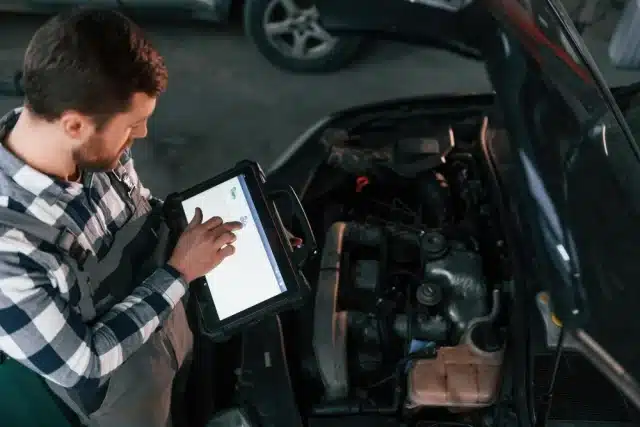Understanding Your Vehicle’s Drivetrain
Your vehicle’s drivetrain is a complex system that transfers power from the engine to the wheels, enabling your car to move. When issues arise within this system, it can lead to a range of problems affecting your vehicle’s performance, safety, and efficiency. Recognizing the signs of drivetrain issues and understanding the diagnostic process can help you address problems early, potentially saving you time and money on extensive drivetrain repair.
Common Signs of Drivetrain Issues
Before diving into the diagnostic process, it’s important to recognize the signs that may indicate a problem with your drivetrain:
- Unusual noises (whining, clunking, or grinding)
- Vibrations while driving
- Difficulty shifting gears
- Slipping transmission
- Burning smell
- Leaking fluids
- Check engine light illumination
If you notice any of these symptoms, it’s time to consider a thorough drivetrain diagnostic.
The Importance of Proper Diagnostics
Accurate diagnostics are essential for effective drivetrain repair. Here’s why:
- Prevents misdiagnosis and unnecessary repairs
- Identifies the root cause of the problem
- Saves time and money in the long run
- Ensures all related issues are addressed
- Helps maintain the longevity of your vehicle
A comprehensive diagnostic approach is key to resolving drivetrain issues efficiently.
Steps in Drivetrain Diagnostics
Professional drivetrain diagnostics typically involve several steps:
- Visual inspection
- Computer diagnostics
- Road test
- Fluid analysis
- Component testing
Each of these steps provides valuable information about the state of your drivetrain.
Visual Inspection: The First Line of Defense
A visual inspection is often the first step in drivetrain diagnostics. This involves:
- Checking for visible leaks or damage
- Inspecting belts and hoses
- Examining the condition of mounts and connections
- Looking for signs of wear on accessible components
- Assessing the overall condition of the drivetrain
This initial inspection can often reveal obvious issues or point to areas needing further investigation.
Computer Diagnostics: Tapping into Your Vehicle’s Brain
Modern vehicles are equipped with sophisticated onboard computers that monitor various systems, including the drivetrain. During computer diagnostics:
- Error codes are retrieved and analyzed
- Live data from sensors is examined
- Performance parameters are evaluated
- Historical data is reviewed for patterns
This electronic analysis can provide valuable insights into the functioning of your drivetrain.
Road Testing: Experiencing the Issue Firsthand
A road test is an essential part of drivetrain diagnostics. It allows technicians to:
- Experience the reported issues firsthand
- Identify any intermittent problems
- Assess the vehicle’s performance under various conditions
- Confirm or rule out potential causes
- Gather additional information for further testing
This hands-on approach helps ensure that no issues are overlooked during the diagnostic process.
Fluid Analysis: What Your Transmission Fluid Can Tell You
Transmission fluid is the lifeblood of your drivetrain. Analyzing it can reveal a lot about the health of your system:
- Color and odor indicate fluid condition
- The presence of metal particles suggests internal wear
- A burnt smell may indicate overheating
- Low fluid levels can point to leaks
- Contamination might suggest seal failures
Fluid analysis is a critical component of thorough drivetrain diagnostics.
Component Testing: Getting to the Heart of the Matter
When initial diagnostics don’t provide a clear answer, individual component testing may be necessary. This can involve:
- Pressure testing of the transmission
- Electrical testing of sensors and solenoids
- Mechanical inspections of gears and bearings
- Evaluation of clutch performance
- Testing of the torque converter
These detailed tests help pinpoint specific issues within the drivetrain system.
Interpreting Diagnostic Results
Once all diagnostic steps are complete, the results need to be interpreted to determine the best course of action. This may involve:
- Identifying the primary issue
- Determining related or secondary problems
- Assessing the severity of the problem
- Considering the vehicle’s age and overall condition
- Evaluating repair options and costs
Proper interpretation of diagnostic results is key to effective drivetrain repair.
The Role of Preventive Maintenance
While diagnostics are essential when problems arise, preventive maintenance can help avoid many drivetrain issues:
- Regular fluid checks and changes
- Timely belt and filter replacements
- Addressing minor issues before they escalate
- Following manufacturer-recommended service schedules
- Avoiding aggressive driving habits
Incorporating these practices into your vehicle care routine can significantly reduce the likelihood of major drivetrain problems.
When to Seek Professional Help
While some car enthusiasts may be tempted to diagnose drivetrain issues themselves, there are times when professional help is necessary:
- When you lack the specialized tools for proper diagnostics
- If you’re unsure about interpreting diagnostic results
- When dealing with complex electronic systems
- If the issue involves safety-critical components
- When warranty considerations are involved
Professional drivetrain repair services have the expertise and equipment to handle complex issues effectively.
The Future of Drivetrain Diagnostics
As vehicle technology continues to evolve, so do diagnostic techniques. Future trends in drivetrain diagnostics may include:
- Increased use of artificial intelligence in problem-solving
- Remote diagnostics and over-the-air updates
- Advanced sensor technology for more precise data collection
- Integration of augmented reality in diagnostic processes
- Predictive maintenance based on big data analysis
Staying informed about these advancements can help you make better decisions about your vehicle’s care.
Understanding the diagnostic process for drivetrain issues empowers you as a vehicle owner. By recognizing the signs of potential problems, appreciating the importance of thorough diagnostics, and knowing when to seek professional help, you can ensure that your vehicle receives the care it needs. Remember, early detection and proper diagnosis are key to effective drivetrain repair and maintenance. By staying proactive and informed, you can keep your vehicle running smoothly and avoid costly repairs down the road.

Speaks from heart, always too passionate and driven by emotions. Spins the words with kindness & sharpness, intriguing your ever-inscrutable minds.


